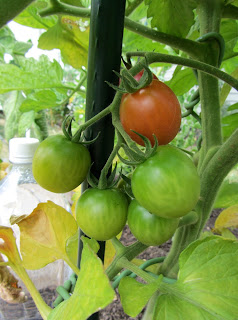At the start of the growing season I had extra seedlings that were left on the back porch. These included a few Kimberley seedlings, which I grew because of reviews of Kimberley's great flavor, especially for an extremely early variety. One of the Kimberley seedlings even started setting fruit while it was still in a 2" cell, so I ended up planting more Kimberley seedlings on July 11th, just over a month after I had planted most of my seedlings.
Now, almost seven weeks later, the first Kimberley only grew to about 15" tall. Its first fruit started blushing on August 15th, 35 days after transplant, and the tomato was 0.8 oz. When the plant set 12 fruit, I removed the remaining blossoms and growing tip since the plant was too small to support more fruit. The fruit have been ripening in the last week, but they're smaller (about 0.5 oz.) compared to the typical 0.7-0.9 oz. fruit from another, larger Kimberley plant planted on June 3rd.
A 15" Kimberley plant with several smaller fruit ripening just five weeks after transplant
A closeup of the fruit on the stunted Kimberley
The second 30" tall Kimberley with a lot more fruit forming 3 weeks later
The larger fruit on the second Kimberley are 1.5-2" in diameter
Most of the other fruit on the second Kimberley are at least 1" in diameter
Thus, based on my Kimberley plants, it's better to remove fruit and open flowers from very small seedlings, those in 2" cells or even 4" cells that aren't yet large enough to support fruit formation. While the plants will take longer to set fruit, they will use their energy to develop into larger plants with deeper roots. The larger plant will also produce more fruit and larger tomatoes.
Transplanting later in the season, when the weather is warmer—at least early to mid-July in Seattle—also seems to improve fruit set. The Kimberley plant that was transplanted in mid-July has set about 50% more fruit than the Kimberley planted on June 3rd. Of course, the clear disadvantage is not getting ripe fruit until the end of the season.
Transplanting later in the season, when the weather is warmer—at least early to mid-July in Seattle—also seems to improve fruit set. The Kimberley plant that was transplanted in mid-July has set about 50% more fruit than the Kimberley planted on June 3rd. Of course, the clear disadvantage is not getting ripe fruit until the end of the season.

























































